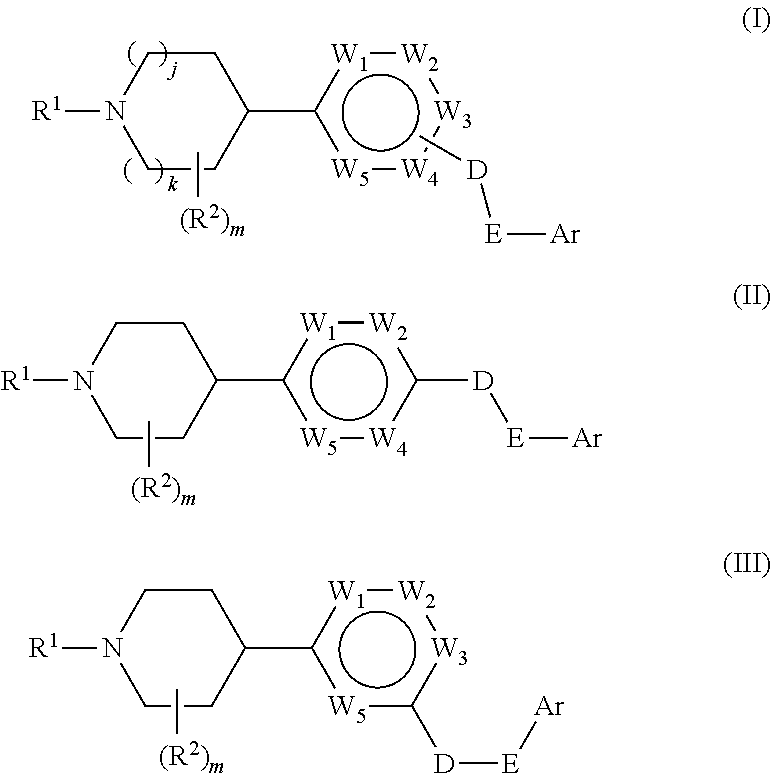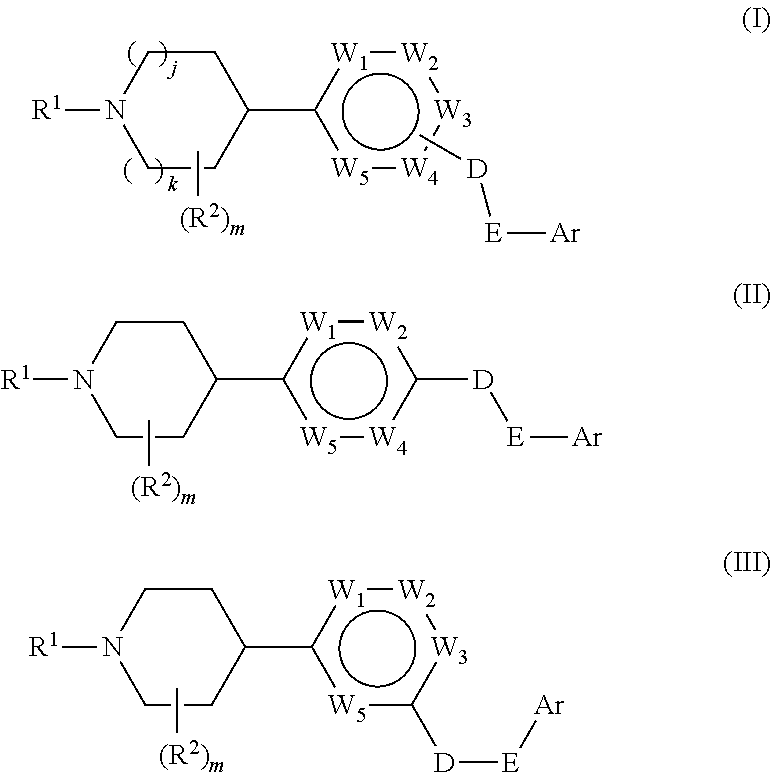Aryl gpr119 agonists and uses thereof
a technology of agonists and aryl gpr119, which is applied in the field ofaryl gpr119 agonists, can solve the problems of hyperglycemia (abnormally high level of glucose in the blood), patients with high levels of these antibodies developing type i diabetes, and reducing the amount of secreted insulin, etc., and achieves the effect of increasing insulin secretion
- Summary
- Abstract
- Description
- Claims
- Application Information
AI Technical Summary
Benefits of technology
Problems solved by technology
Method used
Image
Examples
example 1
tert-Butyl 4-(6-(4-(methylsulfonyl)benzyloxy)pyrimidin-4-yl)piperidine-1-carboxylate
[0257]
Step 1: tert-Butyl 4-(6-hydroxypyrimidin-4-yl)piperidine-1-carboxylate
[0258]
[0259]To a solution of 4-(2-ethoxycarbonyl-acetyl)-piperidine-1-carboxylic acid tert-butyl ester (9 g, 30 mmol) in anhydrous methanol (150 mL) was added sodium methoxide (28 mL, 120 mmol) and then formamidine hydrochloride (4.8 g, 60 mmol) at room temperature. The reaction mixture was stirred at room temperature for 70 hours followed by heating at 50° C. for 2 hours. After cooling the room temperature, the mixture was concentrated under in vacuo. The residue was dissolved in water and extracted with diethyl ether. The aqueous phase was acidified with HCl and extracted with CH2Cl2. The organic phase was dried over anhydrous sodium sulfate, filtered and concentrated to afford the desired product. 1H NMR (CDCl3): δ 8.12 (1H, d), 6.3 (1H, s), 4.25 (2H, br), 2.84 (2H, br), 2.6 (1H, m), 1.88 (2H, m), 1.6 (2H, m), 1.47 (9H, s)...
example 2
tert-Butyl 4-(6-((2-fluoro-4-(methylsulfonyl)phenoxy)methyl)pyridin-2-yl)piperidine-1-carboxylate
[0262]
Step 1: Methyl 6-(1-(tert-butoxycarbonyl)piperidin-4-yl)picolinate
[0263]
[0264]1,2-Dibromoethane (0.15 mL) was added to a suspension of zinc powder (1.3 g) in anhydrous THF (10 mL). The resulting suspension was heated at 65° C. for 5 minutes and then allowed to cool to room temperature. Trimethylsilyl chloride (0.2 mL) was added and the reaction was stirred at room temperature for 30 minutes. N-tert-butoxycarbonyl-4-iodo-piperidine (4.5 g) in THF (10 mL) was added. The reaction mixture was stirred at 50° C. for 2 hours and cooled to room temperature. Meanwhile, a mixture of tri-2-furylphosine (0.2 g) and tris(dibenzylidendacetone)-dipalladium(0) (0.2 g) was dissolved in THF under a nitrogen atmosphere, stirred at room temperature for 30 minutes, and added to the organozinc solution. A solution of methyl 6-chloropicolinate (2.9 g) in THF was added. The reaction mixture was warmed to ...
example 3
5-ethyl-2-(4-(6-((2-fluoro-4-(methylsulfonyl)phenoxy)methyl)pyridin-2-yl)piperidin-1-yl)pyrimidine
[0271]
Step 1: 2-((2-fluoro-4-(methylsulfonyl)phenoxy)methyl)-6-(piperidin-4-yl)pyridine
[0272]
[0273]A solution of tert-butyl 4-(6-((2-fluoro-4-(methylsulfonyl)phenoxy)methyl)pyridin-2-yl)piperidine-1-carboxylate (Example 2) in methanol (10 mL) was treated with 10 mL of 4N HCl in dioxane. The resulting solution was stirred at room temperature for 30 minutes. All the solvents were removed in vacuo to afford the desired product as an HCl salt which was used in the next step without further purification.
Step 2: 5-ethyl-2-(4-(6-((2-fluoro-4-(methylsulfonyl)phenoxy)methyl)pyridin-2-yl)piperidin-1-yl)pyrimidine
[0274]
[0275]A mixture of 2-((2-fluoro-4-(methylsulfonyl)phenoxy)methyl)-6-(piperidin-4-yl)pyridine (1.0 eq.), 2-chloropyrimidine (1.1 eq.) and K2CO3 (4 eq.) in acetonitrile was heated at 82° C. for 4 hours. The suspension was filtered through a pad of celite. The filter cake was washed wi...
PUM
| Property | Measurement | Unit |
|---|---|---|
| Level | aaaaa | aaaaa |
Abstract
Description
Claims
Application Information
 Login to View More
Login to View More - R&D
- Intellectual Property
- Life Sciences
- Materials
- Tech Scout
- Unparalleled Data Quality
- Higher Quality Content
- 60% Fewer Hallucinations
Browse by: Latest US Patents, China's latest patents, Technical Efficacy Thesaurus, Application Domain, Technology Topic, Popular Technical Reports.
© 2025 PatSnap. All rights reserved.Legal|Privacy policy|Modern Slavery Act Transparency Statement|Sitemap|About US| Contact US: help@patsnap.com



